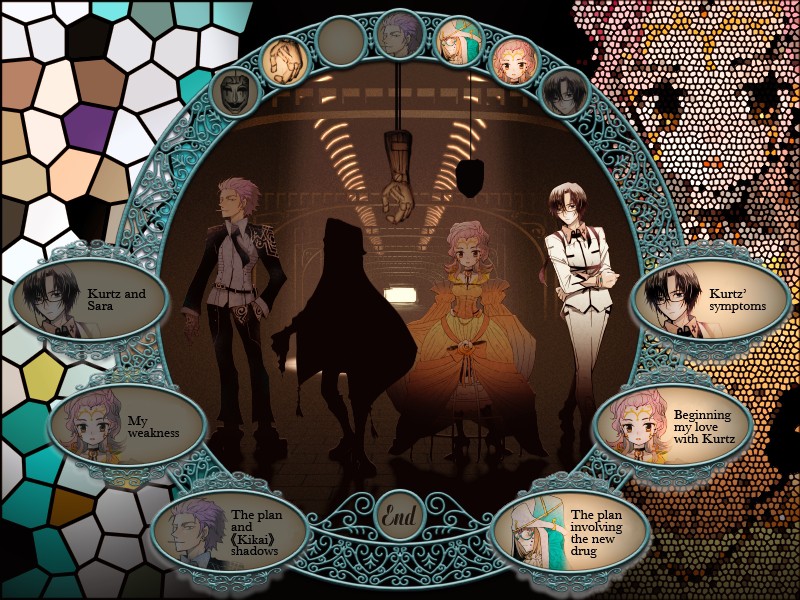Episodic Stories – An Anatomy of Visual Novels
This is a condensed version of the full article which can be found on my Main Blog Here.
Tales From A Distant Land
How a visual novel is structured is perhaps one of the most important, but also the least immediately obvious, element for the player. The way in which the pieces of the narrative fit together often determines the kind of story you are going to tell and tools available to impart emotions and ideas. As such the choice to assume a structure based around Episodic Stories is something worth examining to see exactly what consequences it has on the games created within it. Over the course of this analysis the subtleties of this approach to storytelling for visual novels will be put on full display and also the opportunities it offers for your own work as well as how these features might be integrated into it.
For this article the idea of Episodic Stories will be tackled from two angles, single visual novels where the structure of the game is episodic and a series of visual novels where one game is an episode of a greater narrative. These two are distinct in their implementation but share a lot of the design features which characterise episodic storytelling and putting them side by side will reveal what makes visual novels a prime medium for this style of games.

Internal Episodic Struture
When it comes to the episodic style within a single visual novel there is one method which utilises it in its purest form and this is the Anthology. These games are constructed from a series of mostly self contained episodes that have an overarching direction while not influencing each other to any great extent. This method of narrative presentation allows for the developer to tell a variety of tales with differing themes and also keep a consistent vision between them through common elements due to the structure of the visual novel setting the player’s expectations for the isolated nature of each one. It might not even have a set point of view character as with Corpse Party: Book of Shadows which uses the flexible nature of the anthology format to make each of its episodes focus around different scenarios but it also keeps the core idea of a repeating cycle present in each one so there is a strong sense that they are all tied together.
Even with a strong through line, this kind of Episodic Structure can never truly escape the feeling it is just a collection of pieces rather than a cohesive narrative, since its purity makes its core elements immediately obvious to the player and they will always have this at the back of their mind. Some games, such as Ace Attorney, attempt to mitigate this issue with the inclusion of other mechanics, like point and click and court room challenges, to provide stronger connective tissue through another method of player interaction with the story. However, even these possible aspects can have the opposite effect by contrasting with, and thus highlighting, the self contained nature of each episode and drawing unnecessary attention to it.
On the opposite extreme are the visual novels which use the episodic structure but do not openly attempt to present it to the player and instead blend the beginnings and endings of each story together as best they can. In this case the episodes are generally consigned to a longer common route where they act as tool to control the pacing of this section and the more modular nature of this approach helps hide any possible clunkiness in the transition into a character route. Visual novels utilising this structure tend to belong to the Slice of Life genre with each episode be a different scenario in the characters' everyday lives and the space provided through it facilitates choices that reflect only upon the present moment to mitigate the expectations for consequences. The common route of Cafe Stella is an excellent example of this practice as it has various self contained episodes about things which happen at the cafe that are blended together with a little connective tissue to form the set up for the character routes and gives each character an episode to shine in. The issue with this approach is how little it suits genres outside of Slice of Life, the overall looseness of this type of episodic structure makes the story feel like it lacks substance and nothing of importance is happening, which is the opposite of what is need in a more serious or more plot heavy narrative.

External Episodic Struture
In recent years there has been a trend for releasing shorter visual novels as part of series of episodes within a greater world and narrative. The reason for this shift is in part monetary, visual novels are expensive to make while also mostly having a niche audience to recoup the cost from and this can lead some developers into financial problems. Creating smaller, more digestible and more frequent releases provides a reliable stream of income for the developer and gives the players regular doses of their favourite stories to keep them invested in the universe. Perhaps the most successful example of this model is Grisaia: Phantom Trigger which has reached its eighth volume and maintains a strong fanbase. It took the strong basis of the original Grisaia games and made a more modular version of its core narrative structure (various girls with issues) with fresh faces to draw in new blood. The result is a profitable series that keeps its fans satisfied with a constant trickle of the best aspects of the Grisaia games and keeps the series alive.
Of course money is not the only reason for the existence of episodic releases for visual novels, it also offers a chance to gain the benefits of both short and long form writing. Each individual episode is an inherently short form exercise due to the limited space and as such allows for a more intimate and character focused story to be told without becoming lost in the grander narrative. On the flip-side, the series of episodes in their totality are a long form story that allows the developer to have more in-depth themes and plots due to the greater amount of space available to pace them out without losing the emotion of the individual episodes. Higurashi is a poster child for this approach to narrative structure with each section having been released separately and forming their self contained mysteries which feed into the overarching mystery of the series in an engaging feedback loop.

In Imitation Of TV Or Inherent To Visual Novels?
When it comes to episodic storytelling the first thing most people think of are TV shows since it is incredibility prolific in that medium due to the need to split the viewing experience into manageable chunks. It is clear that for many visual novels this is where they got their ideas about how to adopt the episodic structure into their games. One of the clearest examples of this is The Sliver Case and its sequel which lean into detective shows both aesthetically and structurally. To complement the grimy and noir feeling of the visuals, the games adopts episodic elements by splitting into story into several episodes for different characters and has each of them clearly divided into individual narrative beats with cut-ins as if there is going to be an advertising break which gives the player a point to cleanly leave and come back to the game later. This imitation of of TV undoubtedly has benefits for visual novels leaning into genres normally covered by it but come across as strange in a medium not limited by the same issues as it.
Many episodic stories in visual novels are not in imitation of TV and are instead a variation brought about by the inherent modular nature of their routes. Visual novels thrive in the telling of different connected stories and the clear lines between them which often form are perfect for dividing them into sufficient episodes to increase their individual focus. Perhaps the strongest game to implement this idea is Wonderful Everyday with its collection of interconnected episodes each showcasing a different angle of the same story in a linear order to control their impact on the player. It takes the character focus of the standard visual novel routes and breaks it into more digestible bits where the game can drop hints about the narrative direction while relying on the structure itself to obscure what is actually going on until the very end. Any medium who’s standard structure can be easily broken down into pieces is prime territory for episodic storytelling and visual novels are no exception to this rule.

Conclusion
There is something distinctive about the ways in which visual novels have adapted the episodic storytelling model into their structure. They at once pay homage to their influences while also playing into the advantages their own nature gives them with this tool. Not only is this influence applied to single visual novels but also to entire series of games which play up the same tricks but over a longer time frame to keep their series alive and provide the benefits of short and long term writing. Whether it is to hide the signs where a route begins, betray expectations or present an anthology of individual stories, the episodic model is here to stay within visual novels and presents a compelling case for a the inclusion of even more free-form styles of structure within the medium. Ultimately its use in a visual novel comes down to how well the developer can balance its integration with the other narrative elements they plan on utilising. The more naturally linear your story is the less it benefits from being broken up into episodes and instead it will kill the pacing of the narrative. Despite this complication an episodic structure should definitely be something you should consider the next time you start to develop a visual novel.



1 Comment
Recommended Comments